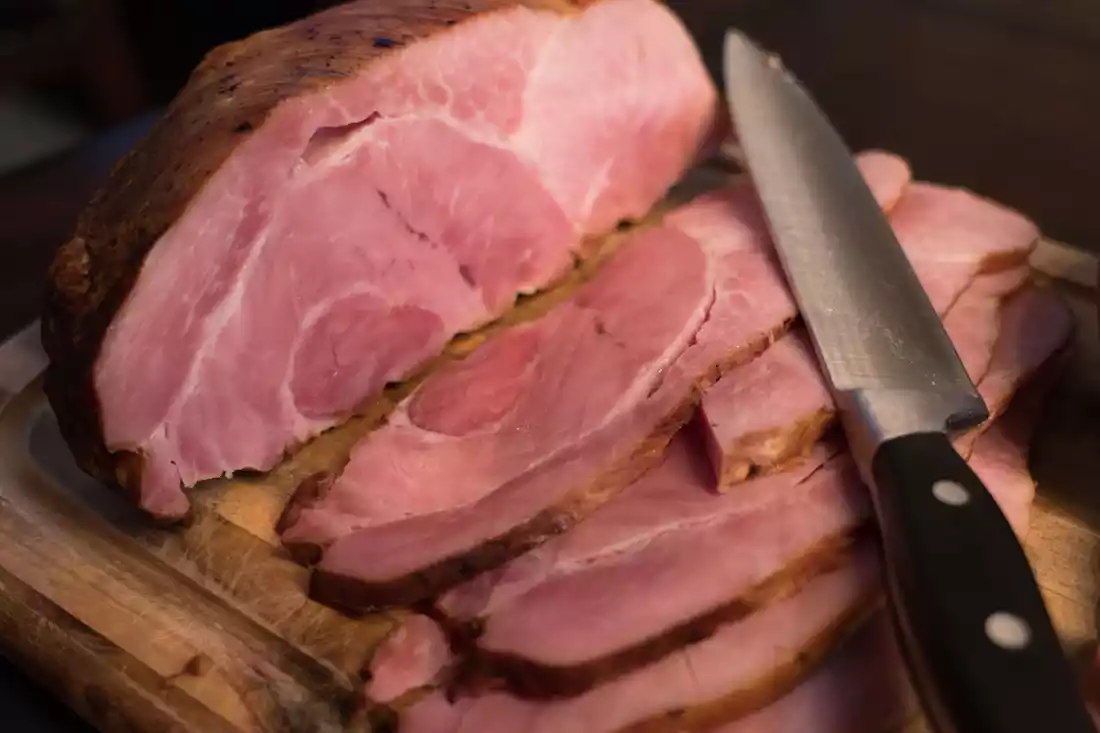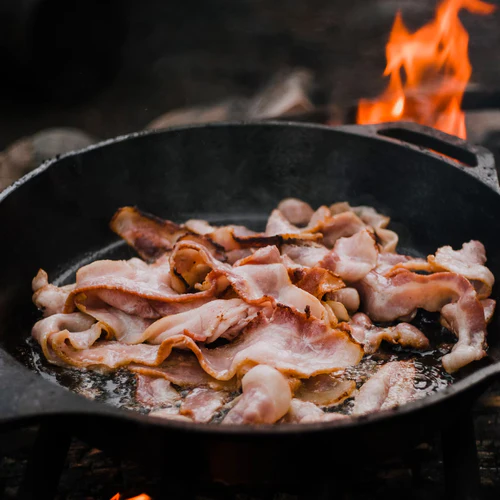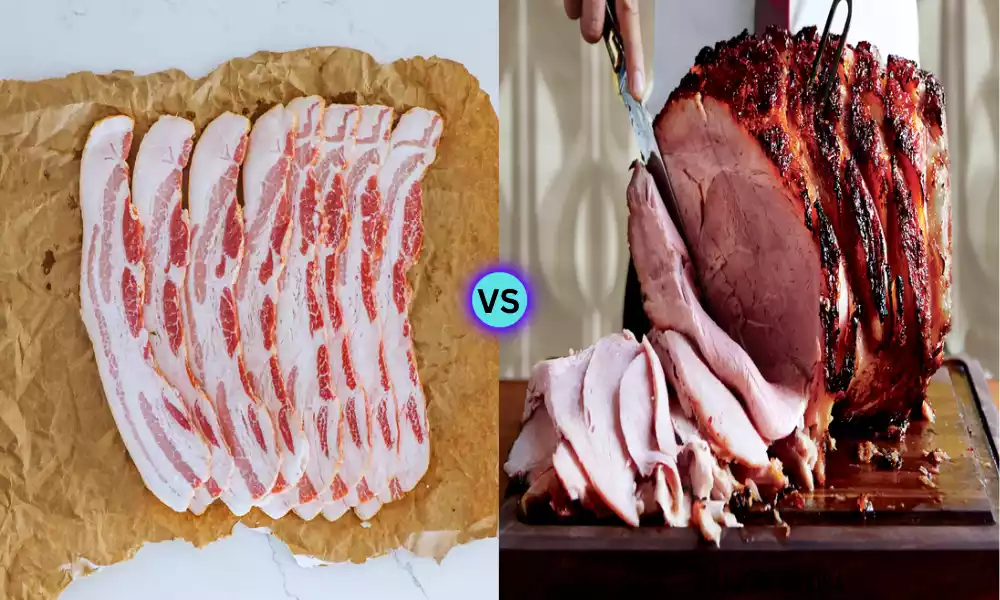Bacon and ham are both popular pork products, but they differ significantly in preparation, taste, and culinary use. Bacon is made from the pork belly or back, which is cured, smoked, and sliced thinly, offering a rich, fatty texture and a savory, smoky flavor. It’s commonly used as a breakfast item, in sandwiches, and as a flavor enhancer in a variety of dishes.
Ham, on the other hand, comes from the hind leg of the pig and is available in many forms, including fresh, cured, or smoked. Ham is generally served in thicker slices or as a larger piece and is often a centerpiece at holiday meals or used in sandwiches and salads. Its flavor can range from mild and sweet to salty and rich, depending on the curing process and seasonings used.
Both bacon and ham hold a cherished place in many cuisines worldwide, celebrated for their distinctive flavors and versatility in cooking.
Definition of Bacon and Ham

Bacon is a salt-cured meat typically made from pork belly or from back cuts that differ in fat content. It’s known for its rich, savory flavor and is often cooked until crisp.
Bacon is widely used in a variety of dishes, from breakfasts to sandwiches, and as a flavor enhancer in recipes. The process of making bacon involves curing the meat in salt and then smoking it, which imparts a distinctive smoky flavor.
Ham, on the other hand, refers to a cut of pork that comes from the hind leg of the pig. It can be found in several forms: fresh, cured, or smoked. The flavor and texture of ham can vary significantly based on the curing and aging process.
Ham is often served as a main course, especially during holidays like Christmas and Easter, and is also used in sandwiches and as an ingredient in various dishes. Its taste can range from mild and sweet to rich and salty, offering versatility in cooking.
Both bacon and ham are integral parts of many culinary traditions around the world and are celebrated for their distinct flavors and diverse applications in cooking.
Types of Bacon
Bacon comes in several types, each varying in cut, flavor, and preparation method. Some of the most common types include:
- American Bacon: Also known as streaky bacon due to its streaks of fat, it’s cut from the pork belly and is known for its rich flavor and crisp texture when cooked. It’s the most common type in the United States.
- Canadian Bacon: Cut from the back of the pig, it is leaner than American bacon and more similar to ham. It’s often sold in round slices and has a more ham-like texture.
- Pancetta: An Italian variety of bacon, pancetta is made from pork belly and seasoned with salt and spices but not smoked. It’s typically sold rolled into a cylinder and sliced thin.
- Peameal Bacon: A type of Canadian bacon that is wet-cured and rolled in cornmeal, giving it a distinctive texture. It’s leaner than American bacon and typically grilled or roasted.
- British Bacon: Also known as back bacon, it’s cut from the loin in the middle of the back of the pig. It’s a combination of lean meat from the loin and fat from the belly.
- Irish Bacon: Similar to British bacon, Irish bacon is typically cut from the back loin and includes a bit of the pork belly. It is generally leaner than American bacon.
- Slab Bacon: This is a full, unsliced piece of bacon that allows you to slice it yourself to the desired thickness. It’s usually cured and smoked pork belly.
- Turkey Bacon: Made from smoked, chopped, and reformed turkey, it’s marketed as a healthier alternative to traditional pork bacon. It has a different texture and flavor but is used in much the same way.
- Applewood Smoked Bacon: This refers to bacon that is smoked using applewood, giving it a distinctively sweet and fruity smoke flavor.
- Hickory Smoked Bacon: Smoked over hickory wood chips, this bacon has a robust, hearty-smoke flavor.
Each type of bacon offers a unique flavor and texture profile, making it suitable for different culinary applications. From adding a rich, smoky taste to breakfast dishes to enhancing the flavor of pasta and salads, the diversity of bacon types provides a wide range of possibilities in the kitchen.
Types of Ham
Ham comes in a variety of types, each with distinct characteristics based on the cut, curing process, and regional influences:
- Fresh Ham: This is the uncured leg of pork. It’s essentially a raw pork roast and lacks the salty, ham-like flavor associated with cured ham.
- Cured Ham: Cured either with a dry salt rub or a wet brine. It includes both country hams (dry-cured and aged) and city hams (wet-cured and typically boiled or smoked).
- Smoked Ham: After curing, this ham is smoked over various types of wood which imparts a distinctive smoky flavor.
- Prosciutto: An Italian dry-cured ham that is usually thinly sliced and served uncooked. It’s known for its delicate texture and sweet flavor.
- Serrano Ham: Similar to Prosciutto, but from Spain. It is dry-cured and typically aged longer than Prosciutto, offering a deeper flavor.
- Black Forest Ham: A German variety, known for its dark color and intense flavor, which it gets from being smoked over pine or fir.
- Virginia Ham: A type of country ham from the U.S., it’s cured with a dry rub, smoked over hardwood and aged. It’s known for its salty and slightly sweet flavor.
- Honey Baked Ham: A type of city ham that’s been wet-cured, smoked, and then glazed with honey, often a popular choice during holidays.
- Iberico Ham: A prestigious Spanish ham made from the Iberico pig, it’s known for its rich marbling and complex, nutty flavor.
- Spiral Cut Ham: These are city hams that have been pre-sliced in a spiral fashion for convenience. They’re often sold with a glaze packet.
- Gammon: A British term for a ham that is typically cured and then boiled or baked. It can be served as a main course or used in dishes like ham and pea soup.
- Bayonne Ham: A French ham, similar to Prosciutto and Serrano, known for its mild, slightly sweet flavor.
Each type of ham offers unique flavors and textures, influenced by regional curing methods and traditions. These varieties allow for a wide range of culinary uses, from simple sandwiches and charcuterie boards to elaborate main courses in festive dinners.
Comparison Table of Bacon vs Ham
Certainly, here’s a comparison table highlighting the key differences between bacon and ham:
| Aspect | Bacon | Ham |
|---|---|---|
| Origin | Made from pork belly or back. | Made from the hind leg of the pig. |
| Texture | Typically has a higher fat content, and can be crispy or chewy when cooked. | Usually leaner, with a texture that varies from smooth to fibrous, depending on the cut and preparation. |
| Flavor | Rich, savory, and often smoky due to the smoking process during curing. | Varies from mild and sweet to rich and salty, depending on the curing and aging process. |
| Curing Process | Cured with salt, and often smoked. | Can be fresh, cured, or smoked. The curing process often involves salting, brining, or smoking. |
| Culinary Uses | Used as a breakfast item, in sandwiches, salads, or as a flavor enhancer in a variety of dishes. | Served as a main dish, especially during holidays, and used in sandwiches, soups, and various recipes. |
| Cooking Methods | Typically fried, baked, or grilled. | Often baked, boiled, or smoked; served in thicker slices or as a whole piece. |
| Nutritional Content | Generally higher in fat and calories. | Can be lower in fat, and higher in protein, depending on the cut. |
| Cultural Significance | A staple in American breakfasts and popular in many cuisines for its versatility. | Associated with holiday meals in many cultures, and varies widely in preparation across different cuisines. |
This table provides a general overview of how bacon and ham differ in various aspects, from their origin and texture to their culinary uses and cultural significance.
Importance in Cuisine

The importance of bacon and ham in cuisine lies in their versatility, unique flavors, and cultural significance:
- Versatility in Cooking: Both bacon and ham can be used in a wide range of dishes. Bacon is known for adding a rich, smoky flavor and a crispy texture to dishes. It is a popular choice for breakfasts, as a topping for salads and soups, and as a flavor enhancer in everything from pasta to baked goods. Ham, with its various forms (cured, smoked, fresh), can be used in everything from hearty main courses to delicate appetizers. It’s also a key ingredient in sandwiches, soups, and stews.
- Flavor Profile: Bacon and ham each offer unique flavor profiles that can elevate a dish. Bacon’s smoky, salty taste adds depth and richness, while ham provides a milder, sometimes sweet or savory note. These distinct flavors allow chefs and home cooks to create complex and appealing taste experiences.
- Cultural Significance: In many cultures, both bacon and ham have traditional and festive roles. For example, ham is often a centerpiece during holiday meals like Christmas and Easter in Western cultures. Similarly, bacon has become synonymous with American breakfasts and is celebrated in various culinary events and festivals.
- Historical Roots: The methods of curing and smoking pork for bacon and ham have historical roots, reflecting the culinary traditions and preservation techniques of different regions and cultures. This historical aspect adds a layer of richness to the culinary heritage and practices of various cuisines.
- Nutritional Value: While both are sources of protein, their different fat content and nutritional profiles allow them to cater to diverse dietary needs and preferences. For instance, leaner cuts of ham can be a healthier option for those looking to reduce fat intake.
- Culinary Inspiration and Innovation: The popularity of bacon and ham has inspired a wide range of culinary innovations and fusion dishes. Chefs and food enthusiasts often experiment with these ingredients, creating new and exciting dishes that blend traditional and modern culinary approaches.
Bacon and ham are cherished in cuisine not only for their distinctive flavors and versatility but also for their cultural, historical, and nutritional aspects, making them indispensable in culinary traditions worldwide.
Production Process
The production processes for bacon and ham involve distinct steps that contribute to their unique flavors and textures:
Bacon Production
- Selection of Meat: Bacon is typically made from pork belly or, less commonly, from the back cuts of a pig.
- Curing: The meat is cured using a mixture of salt, nitrates, and sometimes sugar. The curing process can vary from a wet brine to a dry cure.
- Flavoring: Additional flavorings such as herbs, spices, or even maple syrup may be added during the curing process to infuse different flavors.
- Smoking: After curing, the bacon is often smoked. The smoking process can be done using various types of wood, such as hickory or applewood, which impart different flavors.
- Aging and Drying: Some bacon is aged or dried for a specific period to intensify its flavors, though this is less common in commercial production.
- Slicing and Packaging: Finally, the bacon is sliced and packaged for sale. It can be cut into various thicknesses depending on preference and use.
Ham Production
- Selection of Meat: Ham is made from the hind leg of a pig. The quality and breed of the pig can affect the flavor and texture of the ham.
- Curing: Ham can be either dry-cured or wet-cured. Dry-curing involves rubbing the meat with a mixture of salt and other seasonings and then aging it. Wet-curing, also known as brining, involves submerging the meat in a brine solution.
- Smoking or Cooking: Some hams are smoked for additional flavor. Others are simply cooked or left raw in the case of some traditional dry-cured hams like Prosciutto.
- Aging: Particularly in the case of dry-cured hams, the meat is aged for a period that can range from a few months to several years. Aging develops the ham’s flavor and texture.
- Slicing and Packaging: Ham can be packaged whole, in smaller portions, or pre-sliced. The method of packaging often depends on the type of ham and its intended culinary use.
Both bacon and ham undergo curing processes that not only preserve the meat but also develop deep and complex flavors. The choice of curing method, smoking wood, aging duration, and additional flavorings all contribute to the distinctive taste profiles of bacon and ham. These processes reflect a blend of tradition, culinary art, and science, showcasing the rich history and diversity in the preparation of pork products.
Cooking Techniques
Cooking techniques for bacon and ham vary, each emphasizing the unique qualities of these meats:
Bacon Cooking Techniques
- Pan Frying: The most common method, of pan frying involves cooking bacon over medium heat in a skillet. The bacon is cooked until it reaches the desired level of crispiness, which brings out its rich flavor and texture.
- Oven Baking: Laying bacon strips on a baking sheet and cooking them in an oven is a method that provides even cooking and can reduce the mess and splatter associated with frying.
- Grilling: Grilling bacon adds a unique smoky flavor and is ideal for outdoor cooking. It’s important to watch closely to prevent burning due to the high fat content.
- Microwaving: For a quick and less messy option, bacon can be microwaved between sheets of paper towel, which absorbs excess grease.
- Incorporation into Dishes: Bacon is often chopped and cooked into dishes like soups, salads, and pasta, where it adds a depth of flavor.
Ham Cooking Techniques
- Baking/Roasting: Whole hams are often baked or roasted in the oven, sometimes glazed with ingredients like honey, mustard, or brown sugar to enhance flavor.
- Boiling: Boiling is a traditional way to cook ham, especially popular in some European cuisines. It can be served both hot and cold.
- Grilling: Slices of ham can be grilled, which imparts a smoky flavor and can create an appealing charred texture on the outside.
- Sauteing or Frying: Ham slices can be quickly sautéed or fried in a pan, often used in dishes like sandwiches or breakfast plates.
- Slow Cooking: Cooking ham slowly in a crockpot or slow cooker makes the meat very tender and allows it to absorb flavors from added ingredients like pineapple, cider, or spices.
General Tips
- Temperature Control: For both bacon and ham, controlling the cooking temperature is crucial to avoid burning, especially since these meats often contain sugar from curing.
- Resting After Cooking: Allowing ham to rest after cooking helps redistribute juices, ensuring the meat remains moist and flavorful.
- Safety: It’s important to cook these meats to safe internal temperatures to prevent foodborne illness. For pre-cooked ham, the goal is mainly to heat it through, whereas raw ham needs to be cooked to a safe internal temperature.
These techniques highlight the versatility of bacon and ham, offering a range of options from quick and simple to more elaborate preparations, suitable for a variety of culinary contexts.
Cultural Significance
The cultural significance of bacon and ham extends across various regions and traditions, reflecting their historical, social, and culinary importance:
- Bacon in Western Culture: In countries like the United States, Canada, and the United Kingdom, bacon is a staple of the traditional breakfast. It symbolizes home-cooked comfort and has become an integral part of the cultural identity, often featured in popular media and cuisine. The “bacon craze” in the U.S., with bacon appearing in everything from chocolate to cocktails, showcases its deep-rooted popularity.
- Ham in Festive Celebrations: Ham is often associated with holiday celebrations. In many Western cultures, it is a traditional centerpiece for Christmas and Easter meals. This tradition dates back centuries and is deeply ingrained in the festive culinary practices of these cultures.
- Regional Varieties and Heritage: Different regions have their unique ham specialties, like the Prosciutto di Parma in Italy, Jamón ibérico in Spain, and the Smithfield ham in the United States. These varieties are not just foods; they represent the heritage, tradition, and craftsmanship of their respective regions.
- Religious Influences: The consumption of pork products like bacon and ham is also influenced by religious practices. For instance, they are avoided in Jewish and Muslim diets due to religious dietary laws. This avoidance itself is a significant cultural and social marker for these communities.
- Symbolism in Literature and Art: Bacon and ham often appear in literature and art, symbolizing various themes from abundance and wealth to basic sustenance. Their depiction can reflect the social and economic conditions of the time.
- Global Adaptation and Fusion: With globalization, both bacon and ham have been incorporated into diverse cuisines worldwide, leading to a fusion of tastes and culinary innovation. They symbolize the blending of culinary traditions and the global palate’s adaptability.
- Culinary Traditions and Techniques: The methods of curing and preparing bacon and ham are part of the culinary traditions passed down through generations. These techniques showcase human ingenuity in food preservation and flavor enhancement.
- Community and Identity: In many cultures, the preparation and consumption of bacon and ham are communal activities, bringing families and communities together during meal preparation and celebration, thus fostering a sense of community and identity.
The cultural significance of bacon and ham thus extends beyond their role as food items; they are embedded in the social fabric, traditions, and history of many societies, playing a role in defining cultural identities and culinary heritages.
Health Aspects
Bacon and ham, while delicious and popular, have health aspects that should be considered as part of a balanced diet:
Health Aspects of Bacon
- High-Fat Content: Bacon is high in saturated fat, which can contribute to increased cholesterol levels and risk of heart disease if consumed in large quantities.
- Sodium Levels: The curing process involves a significant amount of salt, making bacon a high-sodium food, which can be a concern for blood pressure and heart health.
- Nitrates and Nitrites: These are often used in the curing process and can form compounds called nitrosamines when cooked at high temperatures, which have been linked to an increased risk of certain cancers.
- Caloric Density: Due to its high-fat content, bacon is calorie-dense, which may contribute to weight gain if not consumed in moderation.
- Protein Source: Bacon provides protein, though it’s not as high in protein compared to leaner meat sources.
Health Aspects of Ham
- Varied Fat Content: The fat content in ham varies depending on the cut. Leaner cuts can be a healthier option compared to fattier cuts.
- Sodium Content: Like bacon, ham is often high in sodium, particularly the cured and smoked varieties, which may affect blood pressure and heart health.
- Preservatives: Cured hams may contain nitrates and nitrites, similar to bacon, with the same associated health concerns.
- Rich in Protein: Ham is a good source of protein, which is essential for muscle building and repair.
- Nutrients: Ham provides important vitamins and minerals, including B vitamins, iron, and zinc.
General Considerations
- Moderation: Consuming these meats in moderation is key to enjoying their flavors while minimizing health risks.
- Balance Your Diet: Accompanying bacon or ham with plenty of vegetables and whole grains can help balance out a meal.
- Choose Healthier Variants: Opting for low-sodium, nitrate-free, or leaner versions of these products can be a healthier choice.
- Cooking Method: How these meats are cooked can also impact their health. For example, avoiding charring bacon and including healthier cooking methods for ham can reduce some health risks.
While bacon and ham can be part of a diverse and balanced diet, it’s important to consider their fat, sodium, and preservative content. Moderation and smart dietary choices can help mitigate some of the health concerns associated with these flavorful meats.
Final Opinion
Bacon vs Ham are both cherished pork products, each with distinct qualities. Bacon, known for its rich, smoky flavor and crispy texture, is often used as a flavor enhancer in a variety of dishes.
Ham, sourced from the pig’s hind leg, offers a range of flavors from sweet to salty and is commonly featured in larger meal portions. While both are versatile and culturally significant, they differ in preparation, taste, and nutritional content.



